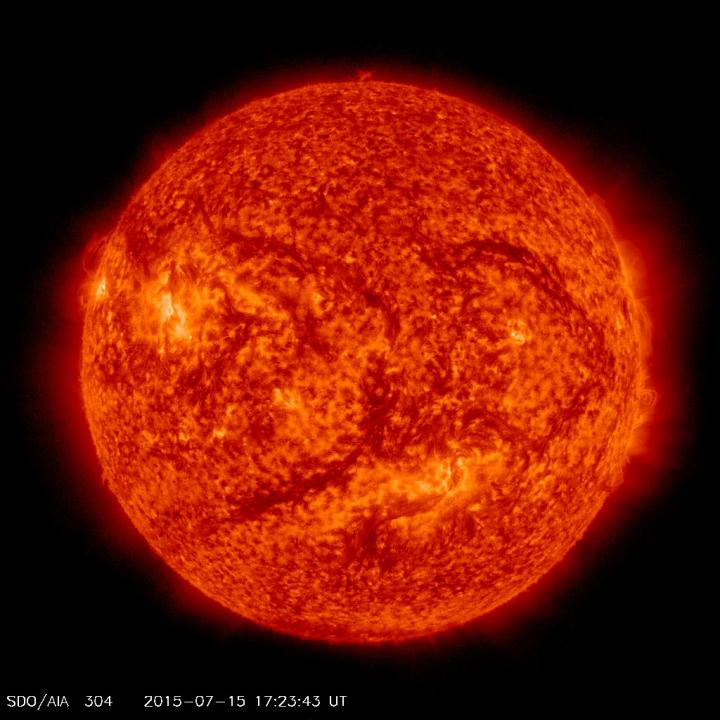 This image of the sun was taken by NASA Solar Dynamics Observations mission on July 15, 2015, at a wavelength of 304 Angstroms.NASA Solar Dynamics Observations
This image of the sun was taken by NASA Solar Dynamics Observations mission on July 15, 2015, at a wavelength of 304 Angstroms.NASA Solar Dynamics Observations
What Is a Little Ice Age, and Are Scientists Predicting Another One?
A Little Ice Age refers to a historical period of significant global cooling, most notably from the 14th to the 19th centuries, with the coldest phase occurring between 1645 and 1700 during the Maunder Minimum. Scientists have long examined solar activity and its cyclical nature to understand how fluctuations in the Sun’s magnetic field influence Earth’s climate.
In 2015, a team of international researchers led by Prof. Valentina Zharkova and Dr. Helen Popova proposed that Earth could enter a similar cooling phase between 2030 and 2040, based on a novel model of solar magnetic field wave interactions. Their findings, first presented at the National Astronomy Meeting in Wales, suggested that a sharp decline in sunspot activity—similar to the Maunder Minimum—could significantly reduce solar irradiance and trigger global cooling.
Now, nearly a decade later, this article revisits the original hypothesis with the benefit of additional solar cycle data, updates from NOAA and other agencies, and a broader perspective on climate modeling. We review the foundations of the original proposal, the analytical tools used, and how current observations compare to the 2015 predictions.
The Science Behind Solar Activity and Climate Impact
Solar Magnetic Fields and Sunspots
The Sun generates its own magnetic field, whose amplitude and spatial structure change over time. These changes are observable in:
- Electromagnetic radiation intensity
- Solar plasma flows
- Frequency and visibility of sunspots
Sunspots follow several cyclical patterns, most notably the 11-year solar cycle and the broader 90-year cycle. A significant drop in sunspot numbers corresponds to a decline in solar irradiance — the amount of solar energy reaching Earth.
Historical Reference: The Maunder Minimum
Between 1645 and 1700, during the Maunder Minimum, sunspot activity dropped dramatically — with only about 50 sunspots recorded, compared to the expected 40,000–50,000. This period saw bitterly cold winters, frozen rivers like the Thames and Danube, and year-round snow in many regions.
Analysis Tools: Principal Component Analysis and Solar Wave Decomposition
To forecast future solar activity, the research team utilized Principal Component Analysis (PCA) on full-disk magnetograms from three previous solar cycles (21–23). PCA helps isolate dominant waveforms from complex, noisy datasets.
“This method can be compared with the decomposition of white light on the rainbow prism detecting the waves of different frequencies,” explained the research team.
Key Findings from PCA:
- Two primary magnetic waves were identified, accounting for 40% of observed solar variance.
- These waves are generated from two different solar layers — inner and outer — and have slightly different frequencies.
- They travel toward opposite hemispheres depending on whether the cycle is odd or even.
Predicting Solar Cycles 24–26 and the Onset of Cooling
Using analytical formulas derived from the wave patterns, the team predicted sunspot activity in cycle 24 with 97% accuracy.
What’s Next: Cycles 25 and 26
Projections indicate that during cycle 26 (approximately 2030–2040), these waves will be out of phase and isolated in opposite hemispheres, significantly limiting sunspot formation. This scenario mirrors the solar dynamics observed during the Maunder Minimum.
“The waves become fully separated into the opposite hemispheres... with little chance of interacting and producing sunspot numbers,” the researchers concluded.
However, more recent data from NOAA’s Space Weather Prediction Center indicates that Solar Cycle 25 is more active than initially expected. Sunspot counts are projected to peak between January and October 2024 at levels significantly higher than early forecasts, suggesting solar activity may not decline as sharply as proposed (NOAA).
Expected Climatic Impact: A Second Little Ice Age?
A reduction in solar irradiance by approximately 3 W/m² could lead to a cascade of climate effects reminiscent of past historical cooling phases:
- Cooler global mean temperatures, particularly in the Northern Hemisphere
- Harsher, prolonged winters in temperate regions such as Europe and North America
- Shortened growing seasons and cold summers, potentially impacting crop yields and food security
- Expansion of glacial masses and changes in oceanic circulation patterns
Historical records from the last Little Ice Age describe significant environmental disruptions, including the freezing of the Thames and Danube rivers, permanent snow cover in parts of Scandinavia, and glacial advances in Greenland and the Alps. These phenomena underscore the far-reaching consequences that even modest reductions in solar energy can have on regional climates.
“If the existing theories about the impact of solar activity on the climate are true, then this minimum will lead to a significant cooling,” said Dr. Helen Popova.
Yet, as scientific understanding of climate systems has evolved, multiple contemporary studies now emphasize that solar activity plays a secondary role in modern climate dynamics. According to NASA and the Intergovernmental Panel on Climate Change (IPCC), total solar irradiance has fluctuated by less than 0.1% over the past several decades. In contrast, anthropogenic greenhouse gas emissions have introduced substantially more radiative forcing, leading to a strong warming trend. As summarized by Greenly Earth, solar variability alone cannot account for current global temperature increases, suggesting that any cooling influence from a solar minimum would likely be muted or offset by human-driven warming.
The Solar–Climate Connection: Mechanisms and Consequences
Radiative and Atmospheric Effects
- A 1% change in solar electromagnetic output can cause significant shifts in temperature and air flow globally.
- Ultraviolet radiation fluctuations lead to ozone formation, altering the stratospheric temperature profile and affecting weather patterns.
Particle Emissions and Cosmic Rays
- High solar activity releases charged particles that can disrupt communications and trigger aurorae.
- Lower solar activity allows more galactic cosmic rays to enter Earth’s atmosphere, altering chemical reactions and possibly increasing cloud formation.
Climate Feedback Loops
Data from Antarctic deuterium analysis show cyclical glaciations and warming over 400,000 years. These cycles appear to be tied to:
- Volcanic activity (linked to greenhouse gas release)
- Solar magnetic strength (modulating cosmic ray intensity and cloud formation)
Caution and Collaboration: A Call for Continued Research
While the model predicts a potential Little Ice Age, scientists remain cautious. Climate systems are complex, governed by a wide range of natural and anthropogenic factors. While solar variability plays a significant role in long-term climate modulation, it is just one of many interrelated drivers.
"We will have to examine it in detail. We keep in touch with climatologists from different countries. We plan to work in this direction," noted Dr. Popova.
Since the initial predictions were made in 2015, further analysis of solar cycles and climate response has led many experts to contextualize solar influence as a contributing—but not dominant—factor. The enhanced complexity of climate models and observational data sets now allow for more refined projections that integrate solar dynamics with greenhouse gas concentrations, ocean-atmosphere interactions, and feedback loops.
Today, the broader scientific consensus maintains that while natural cycles such as solar minima may temporarily slow the pace of warming or cause regional cooling effects, they are unlikely to counteract the dominant influence of anthropogenic greenhouse gases on global climate trajectories. The interplay of these forces underscores the need for continued cross-disciplinary research and policy planning.
Tools and Techniques Used in the Study
| Tool/Technique | Description |
|---|
| Principal Component Analysis | Statistical method used to reduce data dimensionality and identify patterns |
| Solar Magnetograms | Imaging tools capturing magnetic field activity across the solar disk |
| Analytical Modeling | Mathematical prediction of wave behavior and future cycles |
FAQs
Q1: What is a solar cycle?
A solar cycle is an approximately 11-year period marked by fluctuating sunspot numbers and solar magnetic activity.
Q2: What is the Maunder Minimum?
The Maunder Minimum was a prolonged period of low sunspot activity from 1645–1700, associated with a global cooling phase known as the Little Ice Age.
Q3: How does PCA help in solar research?
PCA helps isolate dominant magnetic wave patterns from noisy solar data, aiding in accurate modeling and prediction of solar cycles.
Q4: Could a future Little Ice Age be as severe as the last one?
It is possible, but unlikely to be as severe. Scientists predict a multi-decade cooling phase, though modern climate dynamics and emissions may moderate its impact.
Conclusion
The prediction of a potential Little Ice Age between 2030 and 2040 is rooted in detailed analyses of solar magnetic activity using advanced modeling techniques. However, updated solar observations and contemporary climate models suggest that such a dramatic cooling event may be less likely than originally proposed. With Solar Cycle 25 showing unexpected strength and greenhouse gas concentrations continuing to rise, the dominant drivers of climate appear to remain anthropogenic.
Laboratory professionals, atmospheric scientists, and climatologists alike will continue monitoring solar cycles closely, integrating long-term solar trends with broader climate data to refine predictions and guide climate readiness strategies. For those in environmental science and climate research, understanding the Sun’s influence is essential — not just as an isolated factor, but as one piece in the broader puzzle of global climate change.
What Is a Little Ice Age, and Are Scientists Predicting Another One?
A Little Ice Age refers to a historical period of significant global cooling, most notably from the 14th to the 19th centuries, with the coldest phase occurring between 1645 and 1700 during the Maunder Minimum. Scientists have long examined solar activity and its cyclical nature to understand how fluctuations in the Sun’s magnetic field influence Earth’s climate.
In 2015, a team of international researchers led by Prof. Valentina Zharkova and Dr. Helen Popova proposed that Earth could enter a similar cooling phase between 2030 and 2040, based on a novel model of solar magnetic field wave interactions. Their findings, first presented at the National Astronomy Meeting in Wales, suggested that a sharp decline in sunspot activity—similar to the Maunder Minimum—could significantly reduce solar irradiance and trigger global cooling.
Now, nearly a decade later, this article revisits the original hypothesis with the benefit of additional solar cycle data, updates from NOAA and other agencies, and a broader perspective on climate modeling. We review the foundations of the original proposal, the analytical tools used, and how current observations compare to the 2015 predictions.
The Science Behind Solar Activity and Climate Impact
Solar Magnetic Fields and Sunspots
The Sun generates its own magnetic field, whose amplitude and spatial structure change over time. These changes are observable in:
- Electromagnetic radiation intensity
- Solar plasma flows
- Frequency and visibility of sunspots
Sunspots follow several cyclical patterns, most notably the 11-year solar cycle and the broader 90-year cycle. A significant drop in sunspot numbers corresponds to a decline in solar irradiance — the amount of solar energy reaching Earth.
Historical Reference: The Maunder Minimum
To continue reading this article, sign up for FREE to

Membership is FREE and provides you with instant access to eNewsletters, digital publications, article archives, and more.













